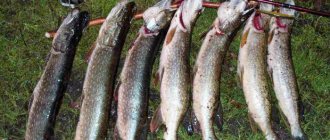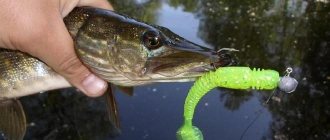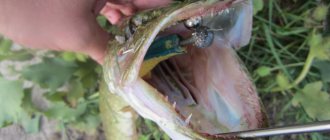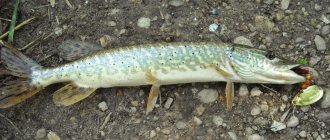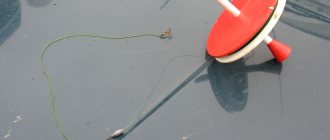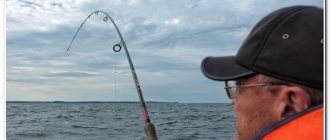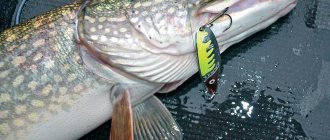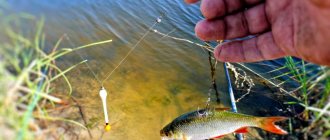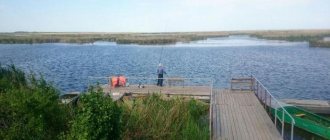Choosing tackle
Autumn jig fishing for pike does not require any particularly strict requirements for gear. Jig equipment requires the use of a classic jig spinning rod with a test weight of 15-40 grams, which has decent rigidity and power, while being light and sensitive. Build quickly. It is determined by the need for powerful hooks when fishing far from the shore. When fishing on the shore, the ability to cast long distances is important, so it is better to use long rods of at least 2.40 meters.
The fishing line is braided. It can provide the necessary sensitivity and at the same time the strength of the gear. Don't forget about a metal or fluorocarbon leash - also a necessary attribute of the gear.
When it comes to catching large pike, the reliability of a spinning reel is important. In many ways, the effectiveness of guiding, landing fish and actually all fishing depends on it.
Preference is given to installation when the hooks remain open. Exception: fishing in very grassy and snagged places. There you will have to resort to installation in the form of hooks. You shouldn’t use a very heavy jig head. Pike often take on the fall, so the bait must sink very smoothly to the bottom, and a heavy sinker can completely eliminate this possibility.
Tackle for pike fishing in autumn
First you need to understand what kind of spinning rod you need. At the very beginning of autumn, when there is still a lot of algae in the reservoirs, complicating long-distance casts, the most suitable option would be a tackle with a length of 210-240 cm with a test of 5-25 g and a middle-class form for catching pike in the fall on lakes. In this case, choose a medium-fast rod action; it is perfect for twitching when the water is burdened with a mass of algae.
Spinning rod Telespin Helios 790 for 1 piece. Spinning rod Samurai Spin 210 Helios 1,765 for 1 piece. Telescopic spinning rod Python 2.7 m 10-30 g (PR-RT-270) Premier Fishing 620 for 1 pc. Telescopic spinning rod Python 2.1 m 5-25 g (PR-RT-210) Premier Fishing 460 for 1 pc. Spinning tel. BULL 2.1m (30-60g) (2134210/12/11) SWD 380 for 1 piece. Spinning rod AZURA AZS-792 HH 20-70g ZETRIX 4,840 per 1 piece. Spinning rod Jig Force ll JF-762MH Hearty Rise 10,010 for 1 pc. Spinning rod Rooky 662M, 5 - 25 g (RKS-662M) NORSTREAM 2,280 for 1 piece. Spinning rod ANVIL 21ML 2.1 m, 5-21 g Maximus 4,791 for 1 piece. Spinning rod Vierra 10-38 g (VRS-702MH) MAJOR CRAFT 7,645 for 1 piece. Spinning rod VIVO Nuovo 2.53 m Graphite leader 32,380 for 1 piece. Spinning rod Amulet 672ML, 5 - 21 g (AMS-672ML) NORSTREAM 6,770 for 1 piece. Spinning rod Sprut Saburo 300XH (9'8" Extra Heavy/Lure:20-50g/Line:10-30lb) SS982XHFS Sprut 6,090 for 1 piece.
On rivers with fast and medium currents, it is recommended to use a rod with a height of 210-240 cm and a weight of 14 to 70 g. These are usually fast action rods with a dry tip for heavy jigging. But after the weather gets colder and the plants die off, it will be possible to radically change the gear. When using coastal spinning, jig rods 250-270 cm long are used to cast to the desired fishing point.
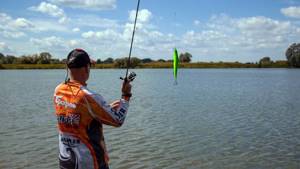
But it is not always possible to find funds for a variety of spinning rods suitable for different fishing conditions, so in such a situation, a simple, budget spinning rod with a test weight of 10-40 g and a length of 240 cm will serve as a universal option. This tackle will serve you as an excellent simulator on which you will learn cast bait. And later, having acquired professional fishing rods, you will be able to provide yourself with a rich catch in any body of water. The reel must also match the class and action of the spinning rod. If you plan to fish on lakes, then reels with a spool volume of 2000-2500, gear ratio from 4.5:1 to 4.9:1 are suitable for you. On the river, power reels from 3000 to 4000 with a spool volume and a gear ratio from 4.5:1 to 4.9:1 are more often used. The tackle is equipped with a 4- or 8-core braided cord with a thickness of 0.1-0.2 mm. This parameter is unimportant when casting evenly, but it affects the casting distance. If you intend to use twitching, then wind the fishing line with the smallest possible cross-section onto the spool so that it does not interfere with jerks during twitching.
We recommend using leashes (metal string or fluorocarbon) between the cord and the load, since after biting the pike often jerks its head, thereby rubbing the cord.
Jig baits for pike
Choosing a pike bait is not as easy as it seems. Many anglers are of the opinion that the color, size, and shape of pike in the fall do not play any role. This opinion is rather erroneous, and the choice of baits needs to be taken more seriously. Indeed, a pike bite can occur on any jig bait, but usually this is an accident. Only a serious approach to choosing pike baits can guarantee a catch and bite from a trophy predator.
The following baits are effective for pike in the fall:
- silicone;
- foam rubber.
Silicone baits
There is a huge amount of “silicone” for jig fishing. Different colors, sizes, designs - all this adds some complexity to the choice.
Preference is given to voluminous baits that float heavily in the water, which are suitable for moving as slowly as possible in predator ambush areas.
Color
It is quite difficult to answer the question of what color pike likes most in autumn. It all depends on the characteristics of a particular reservoir, food supply, and weather conditions. It is believed that bait that imitates the fish that the predator feeds on is the most catchy, but this rule does not always apply. Often pike take on silicone of a color that has nothing to do with its food base. In this case, color is an irritant.
Pike respond best to baits that combine white, green, and red colors; “acid” colors, “machine oil” and transparent baits interspersed with sparkles give good results. The use of the latter depends directly on the transparency of the water and lighting.
There is no need to stop at one recommended color. Experiment! You can only choose the most catchy color yourself.
Size
When choosing the size of a pike bait, everything is a little simpler than with color. Even a small pike can easily attack a fairly large silicone fish. Therefore, for targeted pike fishing with jig, “silicone” from 10-15 cm is used. The minimum size can be used when there is low predator activity or in the absence of trophy fish. It is advisable to use the largest baits in late autumn. It must be remembered that even a large pike will rarely miss a small silicone bait passing by.
About
Choosing a jig head and bait for autumn jig fishing for pike
Silicone and foam fish are equipped with a jig head or a Cheburashka weight with a hook. The weight of the bait should be selected in such a way that after two or three turns of the reel, the bait falls to the bottom for about five seconds. When biting passively, it is advisable to reduce the weight of the bait, and the game will be smoother. There is an absolutely opposite technique - the weight of the bait is specially increased so that when it falls, it falls to the bottom with great force and creates a cloud of turbidity.
When fishing for pike with silicone in the fall in snags, it is absolutely justified to use a bullet-type head weight .
Basic jig lures can be divided into several categories.
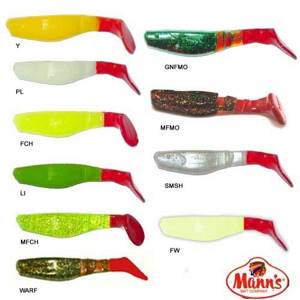
Today's selection of jig baits is so diverse that silicone for pike in the fall can be chosen to suit every taste. In jig fishing, using vibrating tails for pike in the fall is the most promising option. This bait is a soft and flexible fish. Silicone bait for pike in autumn, as a rule, has a size of about 10 cm. It is illogical to use smaller baits in autumn fishing, since fishing during this period is primarily aimed at trophies. And in late autumn, in the vicinity of the pits, larger sizes of baits up to 20 cm can be used. The classic version of this type of bait is Relax Kopyto and Manns Predator - these are legendary baits that will never die. Today, edible silicone has confidently burst onto the market in a wide variety of colors, not only for autumn pike, but also for other types of fish.
Another rubber option for pike in the fall is twister . This is an excellent option for fishing in heavy snags, complete with an offset hook , which is hidden in the body of the bait. In addition to the offset hook, the twister can also be equipped with a tee or double. Twisters without flavors are rarely found today, and the market offers a wide range of different flavors. It is popular to use a twister complete with Moscow equipment. Some fishermen widely use tuning of silicone baits. In the fall, a rubber band for pike can be equipped with noise chambers and create a rattle effect when playing. The body of the twister can be decorated with pieces of thread or pierced with silicone slices. Of course, each angler has his own fishing rod for pike in all seasons, including autumn. The color range of silicone baits is very extensive. Definitely, the assortment should have natural colors - light belly and dark back. Sometimes, in the most hopeless moments, poisonous colors come into play. Color designs using sparkles are widely popular; such baits have a defiant effect on predators. In addition to the legendary silicones listed above, examples of catchy silicone lures for pike in the fall are lucky john, Fanatik, Bait Breath, Keitech.
Foam rubber bait is used very rarely when fishing for pike. To a greater extent, foam rubber is intended for catching pike perch. However, for jigging, dragging or demolition, a foam fish is better suited. And when all the techniques and baits have been tried, then it also makes sense to try foam rubber dragging.
Spinner is a classic bait from the middle of the last century. Both oscillating and front-loaded rotating spinners are excellent for jigging. Spoons are suitable for fishing on reservoirs with a clean bottom , because even minor vegetation and a small number of shells will be hooked almost immediately. Despite the primitive nature of the spinners, you must have them in your assortment, since there are times when it is the spinners that shoot. There are world-famous brands of spinners that are hard for pike to resist. Such oscillators include ACME, Kuusamo, Mepps.
Video: the best silicone lures for catching pike in the fall
Fishing technique
Fishing for pike with a jig has its own characteristics depending on the conditions: the chosen location, weather conditions, the presence of food supply for the predator in the reservoir, the nature of the bottom, the presence of natural shelters for the predator, and many other factors.
All autumn pike fishing is divided into two periods:
- early autumn, during which there is still aquatic and bottom vegetation on the reservoir (September and October, its first half);
- late, when the plants lay down, the water becomes clear and its temperature drops (November).
About
Pike fishing in September
September is characterized by sudden changes in weather; a sunny day can quickly turn into gloomy, rainy and cloudy, and the difference between day and night temperatures can reach 15 degrees. Such conditions significantly complicate autumn fishing, however, this voracious fish is now especially in need of nutrition - it is trying to gain fat for the winter, the glutton begins, this is to the benefit of the fishermen, and knowledge of the peculiarities of its behavior during this period will ensure a decent catch.
Reel Sherman Pro Feeder 4000 (SHPRO4000) Flagman 4 330 for 1 pc. Reel Excia MX 2000 RYOBI 6,075 for 1 piece. Scout 3000 2BB Rubicon 585 reel for 1 pc. Reel Tomado 4+1BB 4000 FD Rubicon 1,245 for 1 pc. Reel Alkazat 4+1BB 4000 FD Rubicon 1,455 for 1 pc. Reel Flanker 4+1BB 3000FD Rubicon 970 for 1 pc. Scout 3000 1BB Rubicon 585 reel for 1 piece.
On cloudless, sunny days, pike prefer shady places near the shore for ambush. Accurate signs of the presence of pike are tree crowns hanging over the water, rich vegetation on the shore, various snags and tree trunks that have fallen into the water, and especially schools of small fish. There is definitely a pike in such a place. In small rivers and creeks it is easy to detect with the naked eye, without special equipment, and it also reveals itself by sharp throws after prey. When the temperature stops reaching 20 degrees, the pike leaves the coastal zone and can be found anywhere in the reservoir where small fish remain.
Jig wiring and its options, features
One of the components of success is correct wiring. There are no special secret autumn wiring techniques.
First you need to try the usual “step” or step retrieving, in which reeling is periodically carried out with a few turns of the reel or a jerk of the rod. Usually this is enough for autumn pike.
It is very effective to use wave-like or simply uniform bottom wiring, in which even inactive fish manage to attack the bait offered to it.
If the fish is completely passive and does not want to react, you can increase the period of the bait falling. A high toss and a slow fall allows you to provoke a pike that stands slightly above the bottom.
Sometimes dragging along the bottom brings results. In this case, when reeling in, the jig bait almost does not come off the bottom. This wiring is carried out slowly and with periodic stops.
No matter what body of water the fisherman is on, you should always experiment with the types of fishing. The choice of wiring type may depend on the bait used, the activity of the fish, and its location in the water layers.
